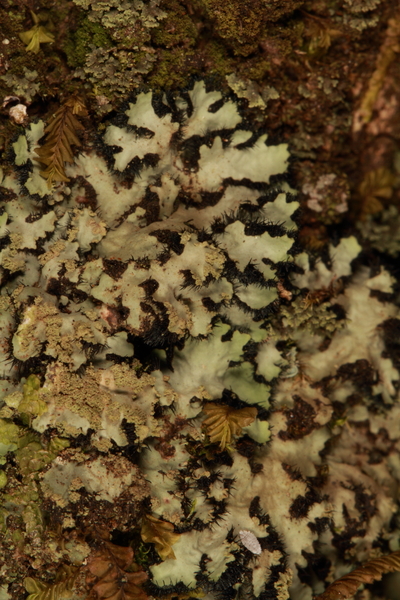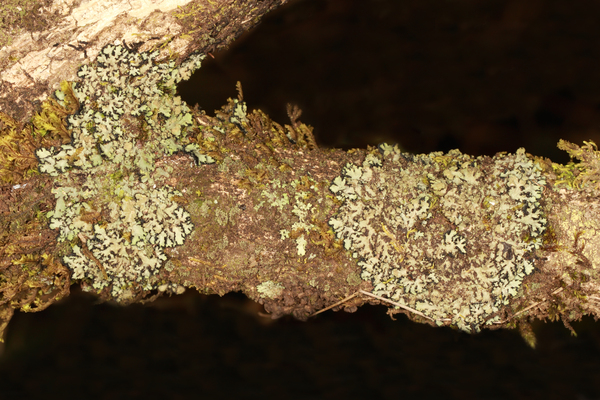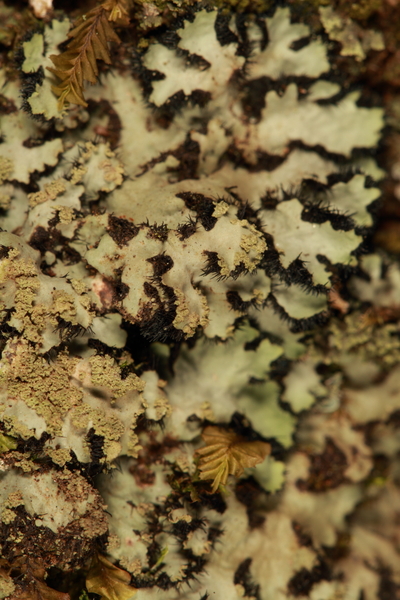Phaeophyscia hispidula (Ach.) Essl.
Mycotaxon, 7: 305, 1978. Basionym: Parmelia hispidula Ach. - Lichenogr. Univ.: 468, 1810.
Synonyms: Physcia hispidula (Ach.) Frey; Physcia setosa (Ach.) Nyl.
Distribution: N - TAA (Nascimbene & al. 2007b, Zarabska & al. 2009), Lomb (Zocchi & al. 1997), Piem (Piervittori 2003, Watson 2014), VA (Isocrono & Ongaro 2021, Ongaro & al. 2022).
Description: Thallus foliose, heteromerous, dorsiventral, forming orbicular to irregular, up to 10(-12) cm wide rosettes. Lobes discrete or partly imbricate, (1-)2-4(-6) mm wide, concave, usually slightly ascending at apex, surrounded by numerous dark, projecting rhizines. Upper surface grey to grey-brown, usually dull, epruinose, with granular to isidioid, mostly marginal or submarginal, soredia which are sometimes gathered in capitate soralia. Lower surface black, sometimes dark brown at lobe ends, with dark, mostly simple rhizines well-projecting beyond the margins. Upper and lower cortex paraplectenchymatous; medulla white. Apothecia very rare, lecanorine, up to 2 mm across, sessile, with a dark disc and an entire to irregularly crenate thalline margin that often bears a dense corona of rhizines. Epithecium brown; hymenium and hypothecium colourless; paraphyses slender, often forked in upper part, the apical cells clavate, with a thin dark cap. Asci 8-spored, clavate, the K/I+ blue tholus penetrated by a faintly amyloid apical cushion with parallel or diverging flanks, the wall K/I-, surrounded by a K/I+ blue outer layer, Lecanora-type. Ascospores 1-septate, brown, ellipsoid, 18-25(-28) x 7-12(-14) µm, Physcia-type. Spot tests: cortex and medulla K-, C-, KC-, P-, UV-. Chemistry: without lichen substances.Note: a mainly circumboreal-montane species, mostly found on terricolous or saxicolous bryophytes in upland areas; rare and restricted to the Alps in Italy.
Growth form: Foliose, narrow lobed
Substrata: rocks, bark, soil, terricolous mosses, and plant debris
Photobiont: green algae other than Trentepohlia
Reproductive strategy: mainly asexual, by soredia, or soredia-like structures (e.g. blastidia)
Commonnes-rarity: (info)
Alpine belt: absent
Subalpine belt: extremely rare
Oromediterranean belt: absent
Montane belt: extremely rare
Submediterranean belt: absent
Padanian area: absent
Humid submediterranean belt: absent
Humid mediterranean belt: absent
Dry mediterranean belt: absent
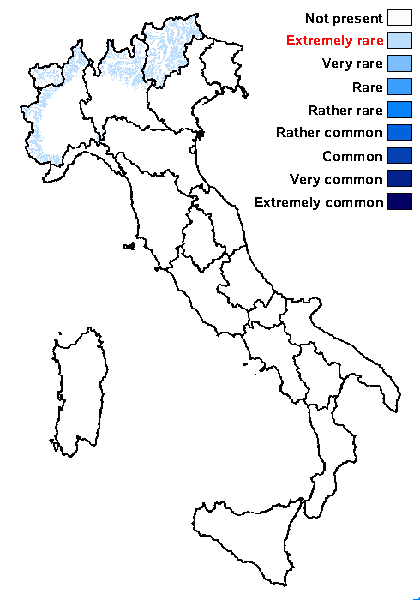
Predictive model
Herbarium samples
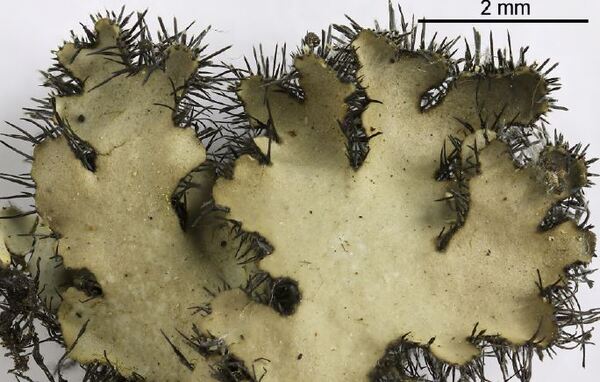

Felix Schumm – CC BY-SA 4.0
[11773], Nord-Thailand, Prov. Chiang Mai, Chiang Mai, Doi Suthep, Monsun-Regenwald beim Phu-Ping-Palast, epiphytisch, 1300 m. Leg. Schäfer-Verwimp 05.April 2004 (Nr. 23706/A), det. Aptroot.
Image from: F. Schumm & A. Aptroot (2012) A microscopical Atlas of some tropical Lichens from SE-Asia (Thailand, Cambodia, Philippines,Vietnam). Books on Demand GmbH, Nordertedt - ISBN 978-3-8448-9259-8
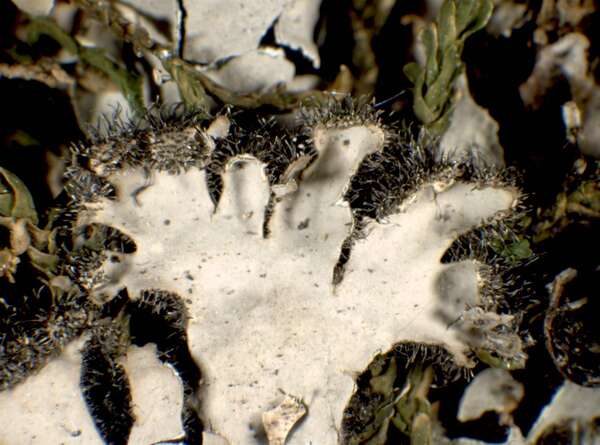

P.L. Nimis; Owner: Department of Life Sciences, University of Trieste
Herbarium: TSB (27262)
2001/12/11
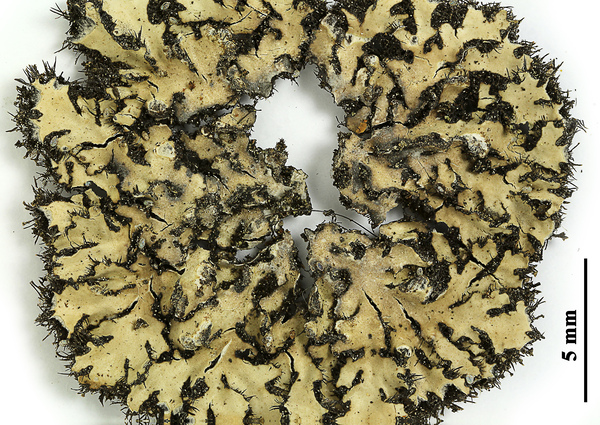

Felix Schumm - CC BY.SA 4.0
[9938], Nova Zelandia. South Island, distr. Nelson, transitus Tantragee, 180 m, ad caementum tubi aquaeducti. Leg. Malcolm 12.12.1997, det.Malcolm. In Vezda: LICHENES RARIORES EXSICCATAE NR. 347


Felix Schumm - CC BY.SA 4.0
[9938], Nova Zelandia. South Island, distr. Nelson, transitus Tantragee, 180 m, ad caementum tubi aquaeducti. Leg. Malcolm 12.12.1997, det.Malcolm. In Vezda: LICHENES RARIORES EXSICCATAE NR. 347
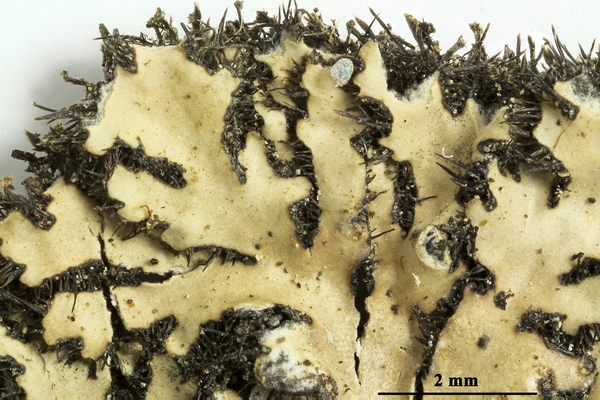

Felix Schumm - CC BY.SA 4.0
[9938], Nova Zelandia. South Island, distr. Nelson, transitus Tantragee, 180 m, ad caementum tubi aquaeducti. Leg. Malcolm 12.12.1997, det.Malcolm. In Vezda: LICHENES RARIORES EXSICCATAE NR. 347
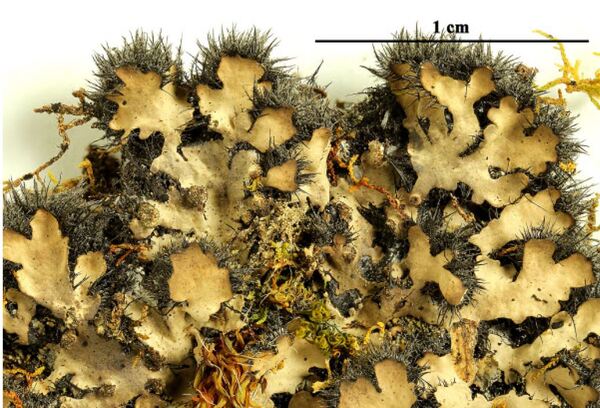

Felix Schumm - CC BY-SA 4.0
[19219], Australien, New South Wales, Abercrombie Caves, 43 km SSE of Blayney, 33°55' S, 149°22' E, 600 m, on soil and debris over limestone rocks in disturbed Eucalyptus woodland. Leg. J.A. Elix (23126), 11.09,1990. LICH. AUSTRALASICI EXS. 215


Felix Schumm - CC BY-SA 4.0
[19219], Australien, New South Wales, Abercrombie Caves, 43 km SSE of Blayney, 33°55' S, 149°22' E, 600 m, on soil and debris over limestone rocks in disturbed Eucalyptus woodland. Leg. J.A. Elix (23126), 11.09,1990. LICH. AUSTRALASICI EXS. 215
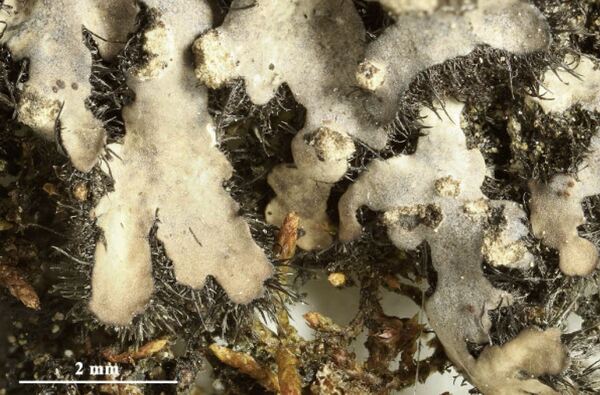

Felix Schumm - CC BY-SA 4.0
[19219], Australien, New South Wales, Abercrombie Caves, 43 km SSE of Blayney, 33°55' S, 149°22' E, 600 m, on soil and debris over limestone rocks in disturbed Eucalyptus woodland. Leg. J.A. Elix (23126), 11.09,1990. LICH. AUSTRALASICI EXS. 215
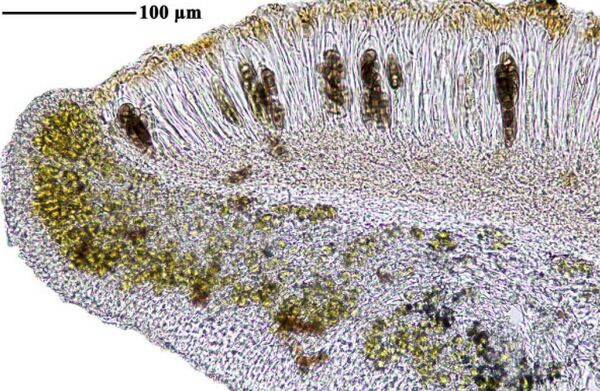

Felix Schumm - CC BY-SA 4.0
[19219], Australien, New South Wales, Abercrombie Caves, 43 km SSE of Blayney, 33°55' S, 149°22' E, 600 m, on soil and debris over limestone rocks in disturbed Eucalyptus woodland. Leg. J.A. Elix (23126), 11.09,1990. LICH. AUSTRALASICI EXS. 215


Felix Schumm - CC BY-SA 4.0
[19219], Australien, New South Wales, Abercrombie Caves, 43 km SSE of Blayney, 33°55' S, 149°22' E, 600 m, on soil and debris over limestone rocks in disturbed Eucalyptus woodland. Leg. J.A. Elix (23126), 11.09,1990. LICH. AUSTRALASICI EXS. 215
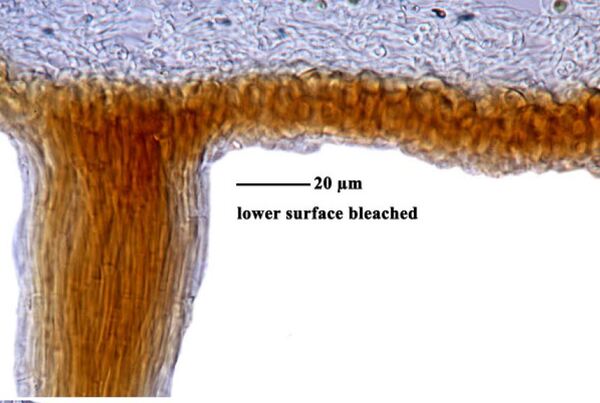

Felix Schumm - CC BY-SA 4.0
[19219], Australien, New South Wales, Abercrombie Caves, 43 km SSE of Blayney, 33°55' S, 149°22' E, 600 m, on soil and debris over limestone rocks in disturbed Eucalyptus woodland. Leg. J.A. Elix (23126), 11.09,1990. LICH. AUSTRALASICI EXS. 215
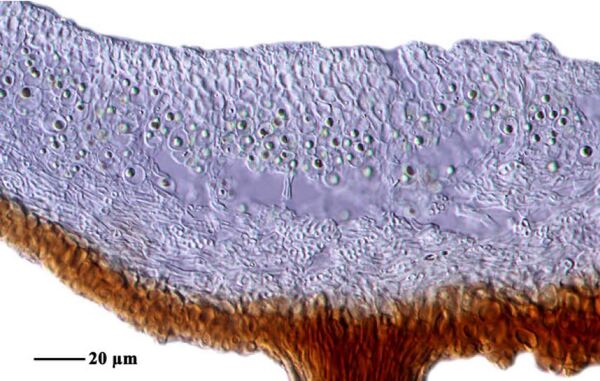

Felix Schumm - CC BY-SA 4.0
[19219], Australien, New South Wales, Abercrombie Caves, 43 km SSE of Blayney, 33°55' S, 149°22' E, 600 m, on soil and debris over limestone rocks in disturbed Eucalyptus woodland. Leg. J.A. Elix (23126), 11.09,1990. LICH. AUSTRALASICI EXS. 215
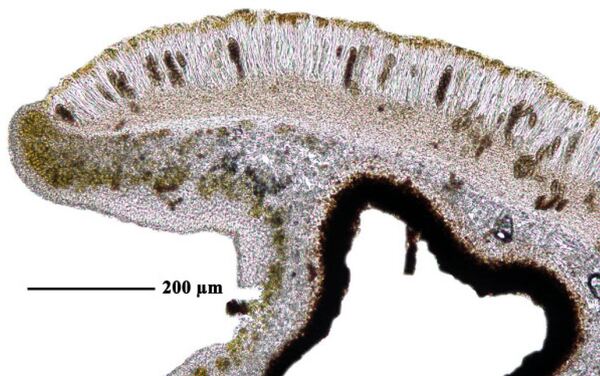

Felix Schumm - CC BY-SA 4.0
[19219], Australien, New South Wales, Abercrombie Caves, 43 km SSE of Blayney, 33°55' S, 149°22' E, 600 m, on soil and debris over limestone rocks in disturbed Eucalyptus woodland. Leg. J.A. Elix (23126), 11.09,1990. LICH. AUSTRALASICI EXS. 215
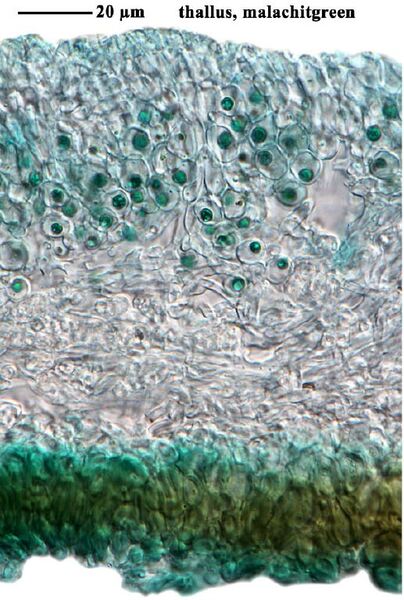

Felix Schumm - CC BY-SA 4.0
[19219], Australien, New South Wales, Abercrombie Caves, 43 km SSE of Blayney, 33°55' S, 149°22' E, 600 m, on soil and debris over limestone rocks in disturbed Eucalyptus woodland. Leg. J.A. Elix (23126), 11.09,1990. LICH. AUSTRALASICI EXS. 215
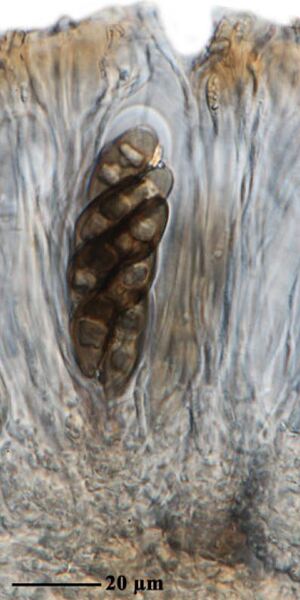

Felix Schumm - CC BY-SA 4.0
[19219], Australien, New South Wales, Abercrombie Caves, 43 km SSE of Blayney, 33°55' S, 149°22' E, 600 m, on soil and debris over limestone rocks in disturbed Eucalyptus woodland. Leg. J.A. Elix (23126), 11.09,1990. LICH. AUSTRALASICI EXS. 215
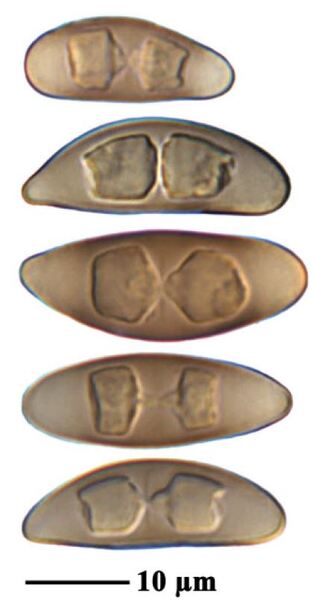

Felix Schumm - CC BY-SA 4.0
[19219], Australien, New South Wales, Abercrombie Caves, 43 km SSE of Blayney, 33°55' S, 149°22' E, 600 m, on soil and debris over limestone rocks in disturbed Eucalyptus woodland. Leg. J.A. Elix (23126), 11.09,1990. LICH. AUSTRALASICI EXS. 215
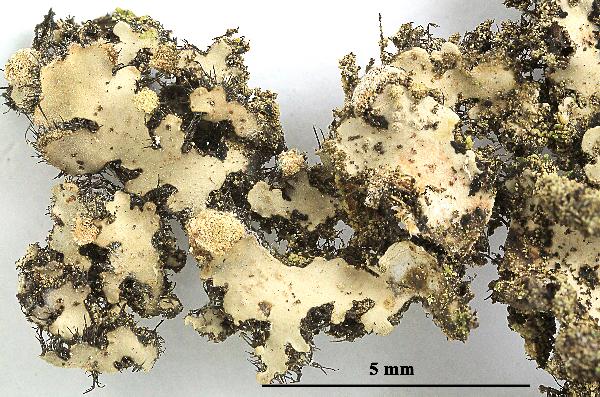

Felix Schumm - CC BY-SA 4.0
[ABL79640], Brazil, Santa Catarina, Urubici, near Pedra Furada State
Park, on exposed siliceous rock. 28°03'20'' S, 49°29'40'' W, 1220 m.
Leg. A. Aptroot (no 79640), 19 July 2019, det. A. Aptroot 2019. - Lobes
brownish grey to greyish brown. Medulla white. Rhizines black projecting
beyond margins and apices. Soralia laminal, pustulate, becoming
capitate. Apothecia uncommon, spores 22-28 x 8-13 μm. No lichen
substances detected


Felix Schumm - CC BY-SA 4.0
[ABL79640], Brazil, Santa Catarina, Urubici, near Pedra Furada State
Park, on exposed siliceous rock. 28°03'20'' S, 49°29'40'' W, 1220 m.
Leg. A. Aptroot (no 79640), 19 July 2019, det. A. Aptroot 2019. - Lobes
brownish grey to greyish brown. Medulla white. Rhizines black projecting
beyond margins and apices. Soralia laminal, pustulate, becoming
capitate. Apothecia uncommon, spores 22-28 x 8-13 μm. No lichen
substances detected
Growth form: Foliose, narrow lobed
Substrata: rocks, bark, soil, terricolous mosses, and plant debris
Photobiont: green algae other than Trentepohlia
Reproductive strategy: mainly asexual, by soredia, or soredia-like structures (e.g. blastidia)
Commonnes-rarity: (info)
Alpine belt: absent
Subalpine belt: extremely rare
Oromediterranean belt: absent
Montane belt: extremely rare
Submediterranean belt: absent
Padanian area: absent
Humid submediterranean belt: absent
Humid mediterranean belt: absent
Dry mediterranean belt: absent

Predictive model
| Herbarium samples |


Felix Schumm – CC BY-SA 4.0
[11773], Nord-Thailand, Prov. Chiang Mai, Chiang Mai, Doi Suthep, Monsun-Regenwald beim Phu-Ping-Palast, epiphytisch, 1300 m. Leg. Schäfer-Verwimp 05.April 2004 (Nr. 23706/A), det. Aptroot.
Image from: F. Schumm & A. Aptroot (2012) A microscopical Atlas of some tropical Lichens from SE-Asia (Thailand, Cambodia, Philippines,Vietnam). Books on Demand GmbH, Nordertedt - ISBN 978-3-8448-9259-8


P.L. Nimis; Owner: Department of Life Sciences, University of Trieste
Herbarium: TSB (27262)
2001/12/11


Felix Schumm - CC BY.SA 4.0
[9938], Nova Zelandia. South Island, distr. Nelson, transitus Tantragee, 180 m, ad caementum tubi aquaeducti. Leg. Malcolm 12.12.1997, det.Malcolm. In Vezda: LICHENES RARIORES EXSICCATAE NR. 347


Felix Schumm - CC BY.SA 4.0
[9938], Nova Zelandia. South Island, distr. Nelson, transitus Tantragee, 180 m, ad caementum tubi aquaeducti. Leg. Malcolm 12.12.1997, det.Malcolm. In Vezda: LICHENES RARIORES EXSICCATAE NR. 347


Felix Schumm - CC BY.SA 4.0
[9938], Nova Zelandia. South Island, distr. Nelson, transitus Tantragee, 180 m, ad caementum tubi aquaeducti. Leg. Malcolm 12.12.1997, det.Malcolm. In Vezda: LICHENES RARIORES EXSICCATAE NR. 347


Felix Schumm - CC BY-SA 4.0
[19219], Australien, New South Wales, Abercrombie Caves, 43 km SSE of Blayney, 33°55' S, 149°22' E, 600 m, on soil and debris over limestone rocks in disturbed Eucalyptus woodland. Leg. J.A. Elix (23126), 11.09,1990. LICH. AUSTRALASICI EXS. 215


Felix Schumm - CC BY-SA 4.0
[19219], Australien, New South Wales, Abercrombie Caves, 43 km SSE of Blayney, 33°55' S, 149°22' E, 600 m, on soil and debris over limestone rocks in disturbed Eucalyptus woodland. Leg. J.A. Elix (23126), 11.09,1990. LICH. AUSTRALASICI EXS. 215


Felix Schumm - CC BY-SA 4.0
[19219], Australien, New South Wales, Abercrombie Caves, 43 km SSE of Blayney, 33°55' S, 149°22' E, 600 m, on soil and debris over limestone rocks in disturbed Eucalyptus woodland. Leg. J.A. Elix (23126), 11.09,1990. LICH. AUSTRALASICI EXS. 215


Felix Schumm - CC BY-SA 4.0
[19219], Australien, New South Wales, Abercrombie Caves, 43 km SSE of Blayney, 33°55' S, 149°22' E, 600 m, on soil and debris over limestone rocks in disturbed Eucalyptus woodland. Leg. J.A. Elix (23126), 11.09,1990. LICH. AUSTRALASICI EXS. 215


Felix Schumm - CC BY-SA 4.0
[19219], Australien, New South Wales, Abercrombie Caves, 43 km SSE of Blayney, 33°55' S, 149°22' E, 600 m, on soil and debris over limestone rocks in disturbed Eucalyptus woodland. Leg. J.A. Elix (23126), 11.09,1990. LICH. AUSTRALASICI EXS. 215


Felix Schumm - CC BY-SA 4.0
[19219], Australien, New South Wales, Abercrombie Caves, 43 km SSE of Blayney, 33°55' S, 149°22' E, 600 m, on soil and debris over limestone rocks in disturbed Eucalyptus woodland. Leg. J.A. Elix (23126), 11.09,1990. LICH. AUSTRALASICI EXS. 215


Felix Schumm - CC BY-SA 4.0
[19219], Australien, New South Wales, Abercrombie Caves, 43 km SSE of Blayney, 33°55' S, 149°22' E, 600 m, on soil and debris over limestone rocks in disturbed Eucalyptus woodland. Leg. J.A. Elix (23126), 11.09,1990. LICH. AUSTRALASICI EXS. 215


Felix Schumm - CC BY-SA 4.0
[19219], Australien, New South Wales, Abercrombie Caves, 43 km SSE of Blayney, 33°55' S, 149°22' E, 600 m, on soil and debris over limestone rocks in disturbed Eucalyptus woodland. Leg. J.A. Elix (23126), 11.09,1990. LICH. AUSTRALASICI EXS. 215


Felix Schumm - CC BY-SA 4.0
[19219], Australien, New South Wales, Abercrombie Caves, 43 km SSE of Blayney, 33°55' S, 149°22' E, 600 m, on soil and debris over limestone rocks in disturbed Eucalyptus woodland. Leg. J.A. Elix (23126), 11.09,1990. LICH. AUSTRALASICI EXS. 215


Felix Schumm - CC BY-SA 4.0
[19219], Australien, New South Wales, Abercrombie Caves, 43 km SSE of Blayney, 33°55' S, 149°22' E, 600 m, on soil and debris over limestone rocks in disturbed Eucalyptus woodland. Leg. J.A. Elix (23126), 11.09,1990. LICH. AUSTRALASICI EXS. 215


Felix Schumm - CC BY-SA 4.0
[19219], Australien, New South Wales, Abercrombie Caves, 43 km SSE of Blayney, 33°55' S, 149°22' E, 600 m, on soil and debris over limestone rocks in disturbed Eucalyptus woodland. Leg. J.A. Elix (23126), 11.09,1990. LICH. AUSTRALASICI EXS. 215


Felix Schumm - CC BY-SA 4.0
[ABL79640], Brazil, Santa Catarina, Urubici, near Pedra Furada State Park, on exposed siliceous rock. 28°03'20'' S, 49°29'40'' W, 1220 m. Leg. A. Aptroot (no 79640), 19 July 2019, det. A. Aptroot 2019. - Lobes brownish grey to greyish brown. Medulla white. Rhizines black projecting beyond margins and apices. Soralia laminal, pustulate, becoming capitate. Apothecia uncommon, spores 22-28 x 8-13 μm. No lichen substances detected


 INDEX FUNGORUM
INDEX FUNGORUM
 GBIF
GBIF
 DOLICHENS
DOLICHENS
